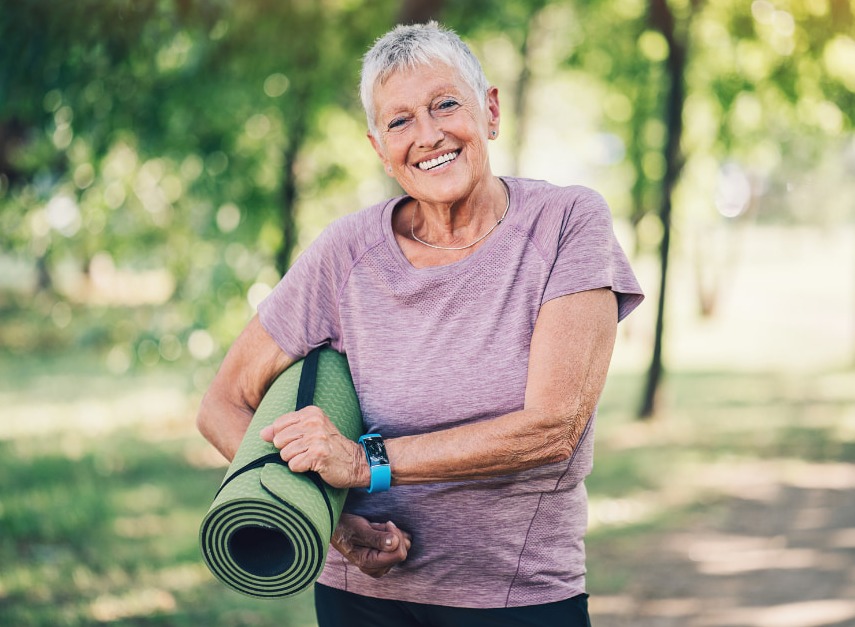Sport and chemotherapy: what type of exercise during treatment?
Published Sep 23, 2024 • By Claudia Lima
Chemotherapy is one of the treatments used to cure various types of cancer. Drugs used in chemotherapy can have a number of side-effects that make it difficult for patients to maintain regular physical activity.
However, a growing body of research shows that sport, when well adjusted to patients' needs and abilities, can play a crucial role in improving quality of life during and after cancer treatment.
What exactly is chemotherapy and what impact does it have on the body? What are the benefits of exercising during chemotherapy? What types of physical activity should you try?
Find all the answers in our article!

What is chemotherapy and what impact does it have on the body?
Chemotherapy is essential in the fight against many types of cancer.
It aims to eliminate cancer cells, either by destroying them directly or by preventing them from multiplying. This is known as systemic treatment, and involves administering a substance that travels through the blood vessels to reach cancer cells throughout the body.
Although effective in targeting and destroying cancer cells, chemotherapy is not without consequences for the body.
Side effects vary depending on the chemotherapy drugs, but certain symptoms are present in the majority of cases. The most common side effects are:
- Intense fatigue, often incapacitating, which does not disappear with rest,
- Nausea and vomiting, induced by the effect of the drugs on the stomach and the digestive cells,
- Loss of muscle mass due to immobility, fatigue and malnutrition. Muscle wasting is a symptom that should be carefully monitored,
- Joint and muscle pain: the body becomes more rigid and painful, making movements difficult,
- Body weakness, due to having less physical activity which leads to reduced endurance and physical strength.
For a long time, these side effects led people to believe that it was better to avoid all physical activity during chemotherapy. However, moderate and appropriate exercise can greatly improve the quality of life of patients undergoing this type of cancer treatment.
What are the benefits of exercising while on chemotherapy?
Generally speaking, sport helps patients to come to terms with their bodies, to feel good after the treatments they have undergone, and to regain tone and flexibility.
Appropriate exercise offers a number of major benefits to patients undergoing chemotherapy:
- Reduced fatigue: moderate-intensity exercise helps to reduce chemotherapy-related fatigue. It stimulates blood circulation and releases endorphins, hormones that improve mood and energy.
- Improved psychological well-being: anxiety and depression are common during treatment. Even light exercise releases hormones such as serotonin, contributing to a better mood and reducing stress. The concentration required to carry out an activity prevents you from thinking about your illness during exercise. What's more, taking part in a group activity allows you to meet new people and break the isolation into which the disease can plunge you.
- Preservation of muscle mass: inactivity can accelerate muscle loss, but gentle resistance exercises can limit this loss, maintaining strength and functional independence.
- Better management of side effects of treatments: regular physical activity can also reduce other side effects, such as nausea and joint pain.
Physical activity and sport can quickly become a patient's best ally throughout the whole treatment process.
What are the benefits of exercising after chemotherapy treatment?
Physical activity helps combat fatigue and facilitates a return to social life. In the longer term, it can reduce the risk of recurrence by 50% for certain cancers, such as breast, colorectal and prostate cancer.
After chemotherapy, the body continues to feel the effects of the treatment for several months. Gradual return to exercise is just as beneficial during this recovery phase. This allows you to:
- Feel more fit: after months of treatment, the body needs to regain its strength and endurance.
- Improve your general quality of life: physical exercise helps to regulate sleep, reduce chronic fatigue, and maintain better mobility and flexibility.
- Improve your mental state: continuing to exercise after chemotherapy helps you boost your self-confidence and better manage the emotions associated with remission.
How can you adjust your physical activity during and after chemotherapy?
Physical activity should be introduced gradually and supervised by sports professionals working hand in hand with healthcare professionals. The most important thing is to exercise in a way that is best suited to your current physical abilities and not to push your body beyond its limits.
Here are a few tips for building an appropriate exercise routine:
See a healthcare professional first
Before starting or resuming any physical activity, you should talk to your oncologist or a physiotherapist. They will recommend exercises that suit your physical condition.
Choose your clothes and accessories well
To feel good during a sports session, you need to opt for soft, comfortable clothes. Avoid tight underwear and bras with underwiring. Remember to stay hydrated, and don't forget your water bottle.
Listen to your body
Every day is different during chemotherapy treatment. You have to adapt to the intensity of the sessions and the side effects. It is not a question of following a strict program, but rather of listening to your body.
Give it a gentle start
Even for someone who was considered to be in good physical shape before starting chemotherapy, it is advisable to start with light exercises such as walking or stretching, before intensifying the effort. The aim is to remain active without depleting your energy reserves.
Split your exercise sessions
If a long session seems too difficult, divide it into several short sessions throughout the day. Ten minutes' walking three times a day is already beneficial. A low level of exercise is always a step up from a sedentary lifestyle.
Keep it regular
It is better to do gentle but regular exercise rather than intensive, irregular sessions. Regularity allows the body to get used to and benefit from the advantages of exercise.
Finally, here are a few examples of physical activities suitable for patients undergoing chemotherapy or in the recovery phase:
- Walking: this is the most accessible form of exercise, enabling you to maintain cardiovascular activity without putting too much strain on your body. Plus, the duration and the rhythm can be adjusted.
- Yoga: gentle and soothing, yoga is excellent for improving flexibility, reducing stress and promoting relaxation. You can do simple postures even when you are very tired.
- Swimming: if your doctor allows it, swimming or aquagym sessions are beneficial for the whole body and do not have a negative impact on your joints.
- Light muscle-strengthening exercises: using elastic bands or light weights for strengthening exercises helps combat the loss of muscle mass without traumatizing your muscles or joints.
- Cycling (outside or at home): maintains your heart and leg muscles.
However, there are certain situations that contraindicate any physical activity while on chemotherapy:
- Extreme fatigue,
- Symptomatic anemia (hemoglobin ≤ 8 g/dl),
- A severe infectious syndrome in progress,
- Decompensation of cardiopulmonary disease,
- Bone lesions (contraindication concerns the movements of the affected limb),
- Severe malnutrition.
Most of these situations are temporary. The patient's condition must be regularly reassessed to ensure that it does not hinder their commitment to an active lifestyle.
NB!
Physical activity during and after chemotherapy is not only possible, but also strongly recommended by medical experts.
The earlier in the treatment process that physical activity is initiated, the more beneficial it will be for the patient.
Being physically active during treatment is beneficial for health, fitness, morale and quality of life. However, you need to adjust your exercise to your current physical state and listen to your body's signals.
If you are undergoing treatment or are in the recovery phase, don't hesitate to ask your healthcare team to design an exercise program that suits you the most.
Did you find this article helpful?
Give it a “Like” and share your thoughts and questions with the community in the comments below!
Take care!
Sources :
Qu'est-ce que la chimiothérapie, e-cancer.fr
Sport et cancers : stop aux idées reçues, harmonie-sante.fr
Quel sport pratiquer pendant et après un cancer, mon-cancer.com
Activité physique et cancers : des bénéfices prouvées pendant et après les traitements, e-cancer.fr
Prescrire l'activité physique : un guide pratique pour les médecins, has-sante.fr
L'activité physique et sportive, curie.fr
Quelle activité physique pendant mon cancer, memecosmetics.fr
Sport et cancers, sportetcancer.com
L'activité physique, fondation-arc.org

 Facebook
Facebook Twitter
Twitter


